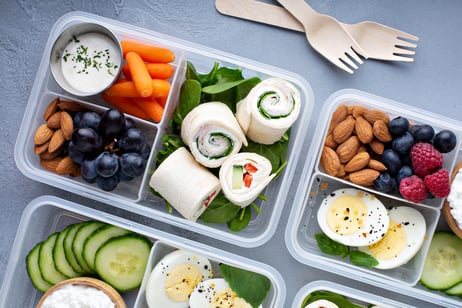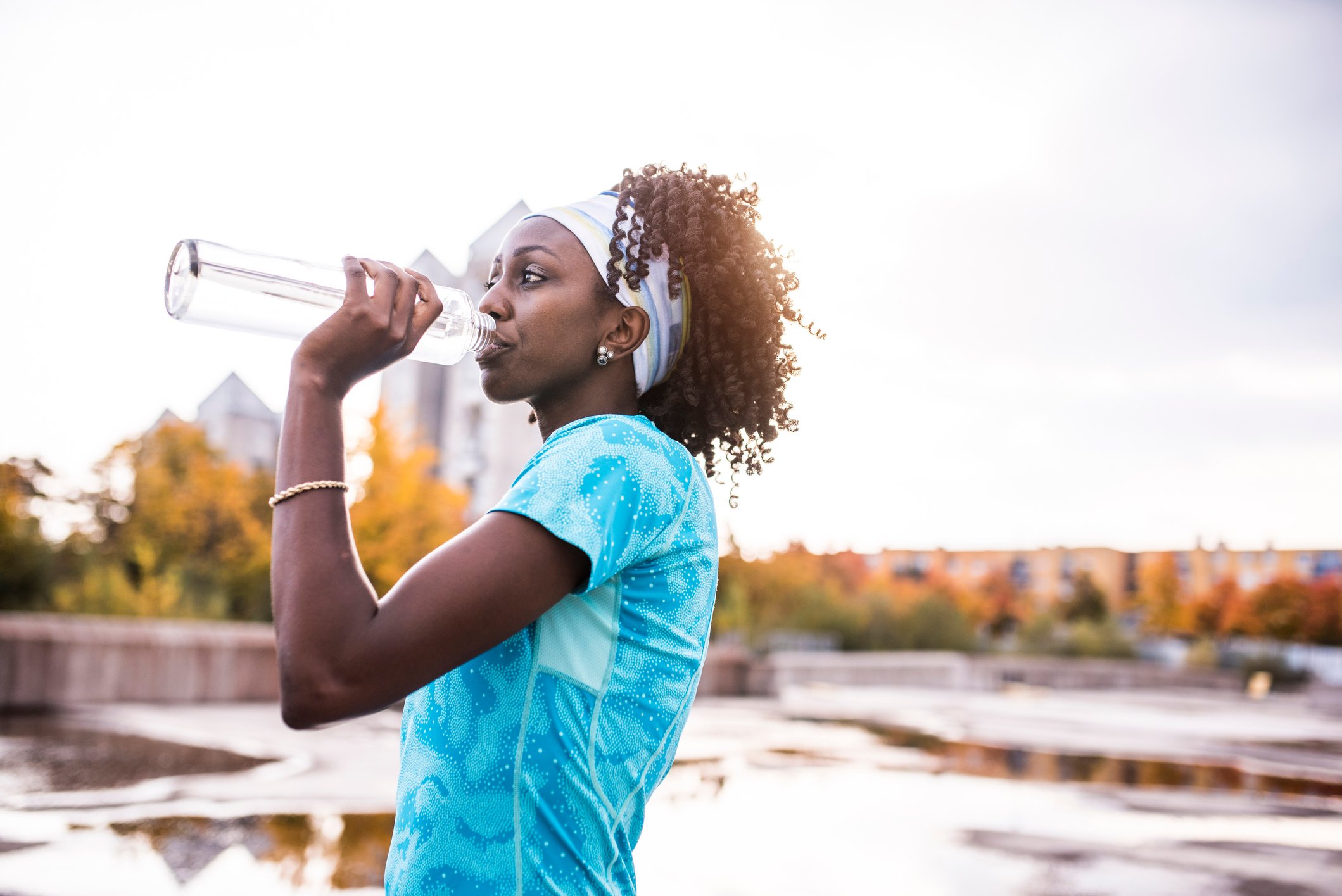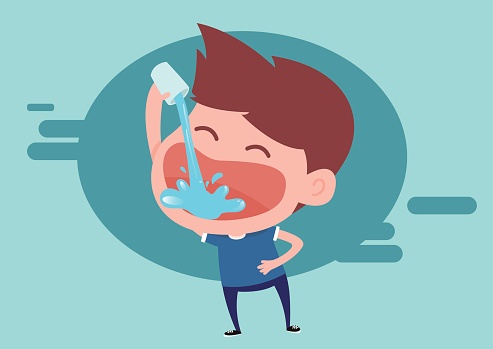Let’s get real: getting healthy and fit (and staying that way) doesn’t happen by accident. In my seven years in the fitness industry I have seen quite a bit—enough to know what works and what doesn’t. The people who are able to reach their healthy, happy weight and maintain it end up developing very similar habits to one another. These healthy habits aren’t anything crazy or extreme, but they consistently allow individuals to lead a healthy lifestyle for years and years.
Today I’ve compiled these habits of healthy people so we can all adapt our own habits to be our healthiest selves.
 1. Start off with a breakfast to FUEL your day.
1. Start off with a breakfast to FUEL your day.
Remember learning that breakfast was the most important meal of the day? While I believe that all meals are important, breakfast definitely is a meal you shouldn’t consider skipping. Studies show that eating breakfast helps to improve focus, satiety, and energy levels throughout the day.
So what does that mean for you? You’ll be more productive at work, will work harder during your workouts, and you may have reduced cravings and hunger later in the day. Sounds like a win, win, win to me!
2. Drink lots of water.
The body is made up of 60% water! Drinking plenty of water throughout the day will help maintain your body’s fluid balance so that nutrients can be transported throughout the body. That means you will more quickly reap the benefits of the healthy foods you eat!
Drinking water throughout the day helps you feel full. It may sound crazy, but many people mistake thirst for hunger and end up overeating.
It’s also important to drink water because when you stress and work your muscles in the gym, they are losing water. If you aren’t drinking enough water, your muscles will get tired faster and you may not be able to work as hard. So drink up, buttercup!
3. Set a deadline.
People are more efficient and more likely to reach their goals with a deadline in the picture. Having a deadline helps to eliminate procrastination and makes the goal seem more tangible and realistic. Having a deadline doesn’t mean you can start being “unhealthy” after you reach your goal, but it simply allows you to have a checkpoint to work toward. Once you reach your goal and deadline, reevaluate and set a new goal! It’s all about progress, not perfection, and there is always something we can improve on when it comes to health and fitness.
4. Don’t leave your healthy-eating goals to chance.
I rarely say NEVER or ALWAYS, but this is an exception to that rule. Never assume that there will be a healthy option when you eat away from home. Always be prepared. Check out the restaurant menu ahead of time, pack healthy snacks, bring a lunch, bring a healthy dish to share, or eat something small before so you aren’t starving. You are in control of your health. It’s not anyone else’s responsibility to make sure there is something nutritious for you to nosh on.
5. Remain consistent.
Consistency is key. We all have days where we skip a workout or overindulge, but as long as healthy is your default, there is no need to sweat it! What matters most is what you do most of the time, not what you do sometimes. So, if choosing healthy (moving your body, eating whole foods, and drinking lots of water) is your sometimes, you may want to switch your mindset.
6. Eat whole, real foods.
Make it your goal to have most of your nourishment come from unprocessed, real foods that are as close to the source as possible. What does that mean? Check out the ingredients. If you are eating a handful of almonds for a snack, the only ingredient should be just that: almonds! Whole foods fill your body with more vitamins and minerals, the nutrition we need to stay healthy on the inside.
7. Fill your home with healthy, nourishing foods.
This tip piggybacks onto the previous piece of advice. If you fill your home with whole foods, they suddenly become a more convenient option than the processed stuff, and less healthy options are eliminated from the picture. If you surround yourself with healthy, delicious food choices, you are more likely to pick those foods when preparing a meal or eating a snack.
8. Take your workout with you.
Many people travel frequently for work, to visit family, or for vacation. While traveling can make it less easy to fit in your workout, it’s definitely not an excuse to slack off in the fitness department. Talk with your trainer about a travel workout option, pack a resistance band or TRX strap, or pack a workout DVD that doesn’t require any equipment at all! There are endless resources for fitness on the go; it just takes a little planning ahead of time.
9. Learn to be politely picky when eating out.
I have learned that I can find something healthy to eat at almost any restaurant. Many times, the option I choose is not listed on the menu. It can be intimidating to ask for special options at a restaurant, but you will be surprised at how accommodating your server and the restaurant want to be. Be polite when you make requests, and your tummy will be happy with the healthy and delicious outcome!
10. Dedicate time to mental health.
Whether you practice yoga, write a journal, meditate, see a therapist, or have another way of dedicating time to your mental health, it is just as important to make time for this type of exercise as it is to make time to go to the gym. Having a healthy mental state will help you stay on track with your fitness goals and will allow you to balance your busy and crazy life with ease. Find the method that works best for you and stick to it!

This blog was written by Tara Deal Rochford, contributing writer, group fitness instructor, and author of healthy living blog Treble in the Kitchen. Meet our other NIFS bloggers.
 Vacation is supposed to be fun, enjoyable, and relaxing. When it comes to weight loss attempts or making healthy choices in general, however, traveling can be a challenge. Here are some of our RD’s best tips for healthy eating when traveling or on vacation.
Vacation is supposed to be fun, enjoyable, and relaxing. When it comes to weight loss attempts or making healthy choices in general, however, traveling can be a challenge. Here are some of our RD’s best tips for healthy eating when traveling or on vacation.


 Alkaline vs. Acid
Alkaline vs. Acid
 What Do Your Kidneys Do?
What Do Your Kidneys Do?
 Did you know the human body is composed of about 50 to 60 percent water? Throughout the day, your body uses and loses fluid by way of natural body processes such as sweating, breathing, creating saliva, making and excreting urine, and having bowel movements. Losing more water than you consume can quickly lead to dehydration, which typically presents as excess thirst, headache, dizziness, weakness, digestion problems, and/or nausea. These symptoms typically resolve once you rehydrate your body.
Did you know the human body is composed of about 50 to 60 percent water? Throughout the day, your body uses and loses fluid by way of natural body processes such as sweating, breathing, creating saliva, making and excreting urine, and having bowel movements. Losing more water than you consume can quickly lead to dehydration, which typically presents as excess thirst, headache, dizziness, weakness, digestion problems, and/or nausea. These symptoms typically resolve once you rehydrate your body. This year make an effort to change small things and create healthier habits. You'd be surprised how little changes can lead to big benefits.
This year make an effort to change small things and create healthier habits. You'd be surprised how little changes can lead to big benefits. One thing that I’m sure you have heard is the importance of
One thing that I’m sure you have heard is the importance of  We’ve waited for this time for months, where there is no more snow and plenty of sunshine. Long days of outside fun, no kids in school, road trips and vacations—what more could we ask for?
We’ve waited for this time for months, where there is no more snow and plenty of sunshine. Long days of outside fun, no kids in school, road trips and vacations—what more could we ask for?
 Fluid (mainly
Fluid (mainly 
 Water is everywhere but where you need it: inside your body. Do you ever check to see how much water you actually consume a day?
Water is everywhere but where you need it: inside your body. Do you ever check to see how much water you actually consume a day?